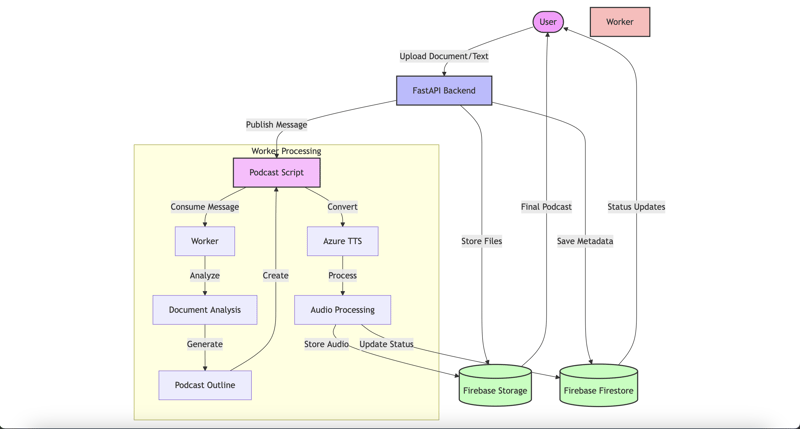如何构建您自己的 Google NotebookLM
来源:dev.to
时间:2024-12-05 16:52:06 486浏览 收藏
今天golang学习网给大家带来了《如何构建您自己的 Google NotebookLM》,其中涉及到的知识点包括等等,无论你是小白还是老手,都适合看一看哦~有好的建议也欢迎大家在评论留言,若是看完有所收获,也希望大家能多多点赞支持呀!一起加油学习~
随着音频内容消费的日益普及,将文档或书面内容转换为真实音频格式的能力最近已成为趋势。
虽然 google 的 notebooklm 在这个领域引起了人们的关注,但我想探索使用现代云服务构建一个类似的系统。在本文中,我将向您介绍如何创建一个可扩展的云原生系统,该系统使用 fastapi、firebase、google cloud pub/sub 和 azure 的文本转语音服务将文档转换为高质量的播客。
这里有一个展示,您可以参考该系统的结果:mypodify showcase
挑战
将文档转换为播客并不像通过文本转语音引擎运行文本那么简单。它需要仔细的处理、自然语言的理解以及处理各种文档格式的能力,同时保持流畅的用户体验。系统需要:
- 高效处理多种文档格式
- 生成具有多种声音的自然声音音频
- 应对大规模文档处理而不影响用户体验
- 为用户提供实时状态更新
- 保持高可用性和可扩展性
架构深度探究
让我们分解关键组件并了解它们如何协同工作:

1.fastapi后端
fastapi 作为我们的后端框架,选择它有几个令人信服的原因:
- 异步支持:fastapi 的异步功能构建于 starlette 之上,可有效处理并发请求
- 自动 openapi 文档:生成开箱即用的交互式 api 文档
- 类型安全:利用 python 的类型提示进行运行时验证
- 高性能:速度可与 node.js 和 go 相媲美
这是我们的上传端点的详细信息:
@app.post('/upload')
async def upload_files(
token: annotated[parsedtoken, depends(verify_firebase_token)],
project_name: str,
description: str,
website_link: str,
host_count: int,
files: optional[list[uploadfile]] = file(none)
):
# validate token
user_id = token['uid']
# generate unique identifiers
project_id = str(uuid.uuid4())
podcast_id = str(uuid.uuid4())
# process and store files
file_urls = await process_uploads(files, user_id, project_id)
# create firestore document
await create_project_document(user_id, project_id, {
'status': 'pending',
'created_at': datetime.now(),
'project_name': project_name,
'description': description,
'file_urls': file_urls
})
# trigger async processing
await publish_to_pubsub(user_id, project_id, podcast_id, file_urls)
return {'project_id': project_id, 'status': 'processing'}
2.firebase集成
firebase 为我们的应用程序提供了两项关键服务:
firebase 存储
- 通过自动缩放处理安全文件上传
- 为生成的音频文件提供 cdn 支持的分发
- 支持大文件断点续传
火库
- 用于项目状态跟踪的实时数据库
- 基于文档的结构非常适合项目元数据
- 自动缩放,无需手动分片
以下是我们实现实时状态更新的方法:
async def update_status(user_id: str, project_id: str, status: str, metadata: dict = none):
doc_ref = db.collection('projects').document(f'{user_id}/{project_id}')
update_data = {
'status': status,
'updated_at': datetime.now()
}
if metadata:
update_data.update(metadata)
await doc_ref.update(update_data)
3. 谷歌云发布/订阅
pub/sub 作为我们的消息传递主干,支持:
- 解耦架构以实现更好的可扩展性
- 至少一次交货保证
- 自动消息保留和重放
- 失败消息的死信队列
消息结构示例:
{
'user_id': 'uid_123',
'project_id': 'proj_456',
'podcast_id': 'pod_789',
'file_urls': ['gs://bucket/file1.pdf'],
'description': 'technical blog post about cloud architecture',
'host_count': 2,
'action': 'create_project'
}
4. 使用 azure 语音服务生成语音
我们音频生成的核心使用 azure 的认知服务语音 sdk。让我们看看我们如何实现听起来自然的语音合成:
import azure.cognitiveservices.speech as speechsdk
from pathlib import path
class speechgenerator:
def __init__(self):
self.speech_config = speechsdk.speechconfig(
subscription=os.getenv("azure_speech_key"),
region=os.getenv("azure_speech_region")
)
async def create_speech_segment(self, text, voice, output_file):
try:
self.speech_config.speech_synthesis_voice_name = voice
synthesizer = speechsdk.speechsynthesizer(
speech_config=self.speech_config,
audio_config=none
)
# generate speech from text
result = synthesizer.speak_text_async(text).get()
if result.reason == speechsdk.resultreason.synthesizingaudiocompleted:
with open(output_file, "wb") as audio_file:
audio_file.write(result.audio_data)
return true
return false
except exception as e:
logger.error(f"speech synthesis failed: {str(e)}")
return false
我们系统的独特功能之一是能够使用人工智能生成多语音播客。以下是我们如何处理不同主机的脚本生成:
async def generate_podcast_script(outline: str, analysis: str, host_count: int):
# system instructions for different podcast formats
system_instructions = two_host_system_prompt if host_count > 1 else one_host_system_prompt
# example of how we structure the ai conversation
if host_count > 1:
script_format = """
**alex**: "hello and welcome to mypodify! i'm your host alex, joined by..."
**jane**: "hi everyone! i'm jane, and today we're diving into {topic}..."
"""
else:
script_format = """
**alex**: "welcome to mypodify! today we're exploring {topic}..."
"""
# generate the complete script using ai
script = await generate_content_from_openai(
content=f"{outline}\n\ncontent details:{analysis}",
system_instructions=system_instructions,
purpose="podcast script"
)
return script
对于语音合成,我们将不同的扬声器映射到特定的 azure 语音:
voice_mapping = {
'alex': 'en-us-andrewmultilingualneural', # male host
'jane': 'en-us-avamultilingualneural', # female host
'narrator': 'en-us-brandonmultilingualneural' # neutral voice
}
5. 后台处理工作者
工作组件处理繁重的工作:
-
文献分析
- 从各种文档格式中提取文本
- 分析文档结构和内容
- 确定关键主题和部分
-
内容处理
- 生成自然的对话流
- 将内容分割成演讲者片段
- 创建主题之间的过渡
-
音频生成
- 使用 azure 的神经语音将文本转换为语音
- 处理多个说话者的声音
- 应用音频后处理
这是我们的工作逻辑的简化视图:
async def process_document(message_data: dict):
try:
# extract content from documents
content = await extract_document_content(message_data['file_urls'])
# analyze and structure content
document_analysis = await analyze_content(content)
# generate podcast script
script = await generate_script(
document_analysis,
speaker_count=message_data['host_count']
)
# convert to audio
audio_segments = await generate_audio_segments(script)
# post-process audio
final_audio = await post_process_audio(audio_segments)
# upload and update status
audio_url = await upload_to_storage(final_audio)
await update_status(
message_data['user_id'],
message_data['project_id'],
'completed',
{'audio_url': audio_url}
)
except exception as e:
await handle_processing_error(message_data, e)
错误处理和可靠性
系统实现了全面的错误处理:
-
重试逻辑
- api 调用失败的指数退避
- 最大重试次数配置
- 失败消息的死信队列
-
状态追踪
- firestore 中存储的详细错误消息
- 向用户实时更新状态
- 监控错误聚合
-
资源清理
- 自动删除临时文件
- 上传清理失败
- 孤立资源检测
扩展和性能优化
为了处理生产负载,我们实施了多项优化:
-
工作人员缩放
- 基于队列长度的水平扩展
- 基于资源的自动缩放
- 区域部署以降低延迟
-
存储优化
- 内容去重
- 压缩音频存储
- cdn 集成交付
-
处理优化
- 类似文档的批量处理
- 缓存重复内容
- 尽可能并行处理
监控和可观察性
系统包括全面监控:
async def track_metrics(stage: str, duration: float, metadata: dict = None):
metrics = {
'stage': stage,
'duration_ms': duration * 1000,
'timestamp': datetime.now()
}
if metadata:
metrics.update(metadata)
await publish_metrics(metrics)
未来的增强功能
虽然当前系统运行良好,但未来的改进还有一些令人兴奋的可能性:
-
增强的音频处理
- 背景音乐整合
- 高级音频效果
- 自定义语音训练
-
内容增强
- 自动章节标记
- 互动文字记录
- 多语言支持
-
平台整合
- 直接播客平台发布
- rss feed 生成
- 社交媒体分享
构建文档到播客转换器是现代云架构的一次激动人心的旅程。 fastapi、firebase、google cloud pub/sub 和 azure 的文本转语音服务的组合为大规模处理复杂的文档处理提供了坚实的基础。
事件驱动的架构确保系统在负载下保持响应,而托管服务的使用减少了运营开销。无论您是要构建类似的系统还是只是探索云原生架构,我希望这次深入研究能够为构建可扩展、生产就绪的应用程序提供宝贵的见解。
想了解更多有关云架构和现代应用程序开发的信息吗?关注我,获取更多技术实用教程。
到这里,我们也就讲完了《如何构建您自己的 Google NotebookLM》的内容了。个人认为,基础知识的学习和巩固,是为了更好的将其运用到项目中,欢迎关注golang学习网公众号,带你了解更多关于的知识点!
-
501 收藏
-
501 收藏
-
501 收藏
-
501 收藏
-
501 收藏
-
142 收藏
-
259 收藏
-
113 收藏
-
327 收藏
-
358 收藏
-
340 收藏
-
365 收藏
-
391 收藏
-
392 收藏
-
105 收藏
-
442 收藏
-
291 收藏
-

- 前端进阶之JavaScript设计模式
- 设计模式是开发人员在软件开发过程中面临一般问题时的解决方案,代表了最佳的实践。本课程的主打内容包括JS常见设计模式以及具体应用场景,打造一站式知识长龙服务,适合有JS基础的同学学习。
- 立即学习 543次学习
-

- GO语言核心编程课程
- 本课程采用真实案例,全面具体可落地,从理论到实践,一步一步将GO核心编程技术、编程思想、底层实现融会贯通,使学习者贴近时代脉搏,做IT互联网时代的弄潮儿。
- 立即学习 516次学习
-

- 简单聊聊mysql8与网络通信
- 如有问题加微信:Le-studyg;在课程中,我们将首先介绍MySQL8的新特性,包括性能优化、安全增强、新数据类型等,帮助学生快速熟悉MySQL8的最新功能。接着,我们将深入解析MySQL的网络通信机制,包括协议、连接管理、数据传输等,让
- 立即学习 500次学习
-

- JavaScript正则表达式基础与实战
- 在任何一门编程语言中,正则表达式,都是一项重要的知识,它提供了高效的字符串匹配与捕获机制,可以极大的简化程序设计。
- 立即学习 487次学习
-

- 从零制作响应式网站—Grid布局
- 本系列教程将展示从零制作一个假想的网络科技公司官网,分为导航,轮播,关于我们,成功案例,服务流程,团队介绍,数据部分,公司动态,底部信息等内容区块。网站整体采用CSSGrid布局,支持响应式,有流畅过渡和展现动画。
- 立即学习 485次学习
